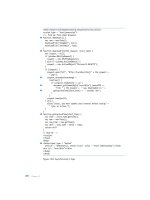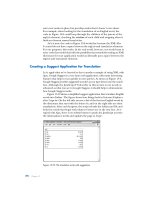Java Server Pages 2nd Edition phần 8 pps
Bạn đang xem bản rút gọn của tài liệu. Xem và tải ngay bản đầy đủ của tài liệu tại đây (482.75 KB, 2 trang )
Chapter 23. Database Access Strategies
426
Chapter 23. Database Access Strategies
In this final chapter, we take a closer look at the strategies for using a database in a web
application that I've mentioned in the previous chapters.
In case you're new to Java database access, we start with a brief overview of the most
important JDBC classes and interfaces. Next, we focus in on the JDBC Connection class
and how pooling Connection objects helps to solve a number of common problems. We
look at two ways to implement connection-pooling capabilities: the JDBC 2.0 way and by
letting a JDBC 1.0 connection pool simulate a JDBC 2.0 pool.
A connection pool can be made available to the rest of the application servlets as well as the
JSTL database access actions in a number of ways. In this chapter we discuss the approach
used in Chapter 18 (using an application event listener) in more detail, as well as an approach
that's more flexible but that only works in web containers that support the Java Naming and
Directory Interface (JNDI).
No matter if you use a servlet or a custom action to access the database, there are a number of
JDBC details that must be handled. To help with this grunt work, we look at a generic
database access bean that simplifies life and makes the result of a query easy to use. The last
section contains an example of an application-specific custom action using this bean.
If you need to learn more about JDBC programming than what's covered here, I recommend
that you look at the JDBC documentation online at or read
a book about JDBC, such as George Reese's Database Programming with JDBC and Java
(O'Reilly).
23.1 JDBC Basics
The JDBC API is a set of classes and interfaces that allows a Java application to send SQL
statements to a database in a vendor-independent way. The API consists mostly of interfaces
that define the methods you use in your program. Database engine vendors and third parties
provide implementations of these interfaces for a specific database engine; such an
implementation is called a JDBC driver. This allows you to develop your program in a
database-independent way and connect to a specific database engine by plugging in the
appropriate JDBC driver at deployment time. There are JDBC drivers for most database
engines on the market, both commercial and open source. If you can't get one from your
vendor, check out Sun's list of third-party drivers at
Figure 23-1 shows how the main interfaces and classes are related.









